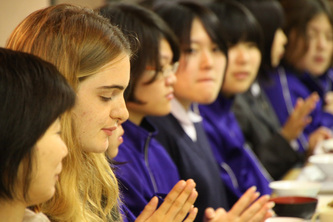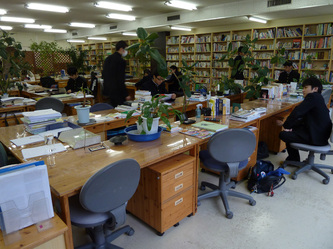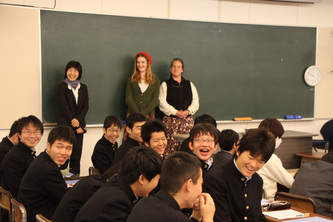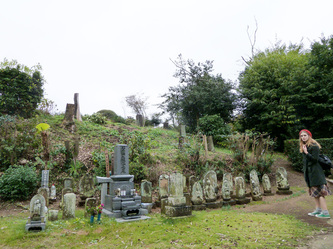Breakfast was chopped lettuce and chopped sugared scrambled eggs. After last night's feast, it was funny to have cafeteria steam table food. Afterwards, we met to be briefed on the opening ceremonies. "Please sing a song," we were asked. Yikes!
At the morning assembly, Camilla and I were stood up on a dais, handed microphones, and asked to introduce ourselves. The students were attentive and sang us two lovely songs, in parts. We sang "Ego Sum Pauper," an old Latin round. Speechifying, clapping, more speechifying, clapping, bowing. At the end, Mr. Oyster bounded onto the dais and yelled, OHAYO GOZAIMASU! and gave a gym-teacher delivery of the morning news, and the plan for the day. When he was done, he called for ... I don't know what, but everyone adjusted themselves into calm, and when they were all quiet and composed, he barked a command, they all bowed deeply, and that was that.
The main classroom is ringed by bookcases, and has desks for all 80 of the kids, arranged in work stations. Some kids chatted, others slept, but most seemed to be working on individual projects. They each are responsible for a potted tree, so the place, which would be a bit grim looking without them, has a quite comfy feeling.
Yayoi took us on a walk around the hill that the school is on. It was a gray day, the vegetation around us is getting ready for fall, and a few tiny blue butterflies flitted around. We could hear crickets. The plants seem tropical, though some winters have a little snow. A pharmaceutical company has a factory near the dam at the base of the hill, but other ambitions to erect an "academic park" didn't materialize. The dam is fed by cement channels and vigorous roadside runnels. Small farms have traditional farmhouses with blue or black curved ceramic roof tiles. There are tiny rice paddies tucked between the road and the hill in odd shaped fields, and enormous kitchen gardens with yams, soybeans, and kales and mustards. Orchards are tightly packed with semi-dwarf trees of all sorts, mostly persimmons, Seville oranges, and chestnuts.
As we walked, birdsong made the place sound like a zoo; melodious trills mixed with prehistoric cackles. Little bamboo forests had a different ecosystem, with a characteristic birdsong coming from near the tops of the bamboo.
We stopped at a house which Yayoi thought might sell bread, but it didn't. Instead there was an open workshop with tschotsches like letter holders and birdhouses. A short old woman with an intricately wrinkled face appeared and gave detailed information which went right over my head.
Next, we found a cemetery. There was a poignant row of stones from the 1700's when there was a cold season and the crops failed. Someone had left a row of beer cans on a newer grave. Wooden prayer sticks, calligraphed by monks for the dead, were arrayed behind some of the newer graves.
A series of three tori, or wooden gates, led up a winding path to a shrine in a bamboo grove. Cut paper hangs in the rice ropes through which the kami can enter. The deep shade, the melodious but unfamiliar birdsong, and the simple wooden shrine gave it a feeling of depth and mystery.
Back at school, we were featured at a nervewracking meeting, where we Camilla and I were shown to a desk facing a semicircle of 15 chairs on which 15 black-suited teachers sat, staring expectantly at us. After an endless wait, the meeting host entered with xeroxed sheets which I'm pretty sure explained who we were and what we could offer. We gave little self-aggrandizing speeches, and then the tension broke. Each of the teachers introduced themselves, and it turns out they all have a sense of humor and all are willing to try being creative in a foreign language. Now we are introduced.
In the evening we were invited to a traditional Japanese restaurant by the younger teachers. We sat at a thick slab of wood with our feet underneath, and ate from an endless stream of dishes, mostly fish. The conversation was friendly and very funny. These guys know how to enjoy themselves!




 RSS Feed
RSS Feed
